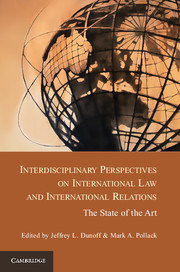 Interdisciplinary Perspectives on International Law and International Relations
Interdisciplinary Perspectives on International Law and International Relations Published online by Cambridge University Press: 05 January 2013
What explains the inclusion of formal dispute settlement procedures in international agreements? Delegating any kind of decision-making comes at a significant sovereignty cost, as Abbott and Snidal (2000: 436) note. From this perspective, instances of delegation are puzzling. Some legal scholars, however, argue that international law becomes more effective the more “lawlike” it is. Helfer and Slaughter (1997: 283), for instance, regard international tribunals as an integral part of “a global community of law.” From this perspective, the absence of dispute resolution mechanisms in some agreements is what begs an explanation.
Based on game theory insights, Koremenos (2007) argues that the inclusion of dispute settlement procedures in international agreements is a deliberate choice by governments, made to address specific cooperation problems. The implication is that international law is designed efficiently: dispute settlement procedures are likely to be incorporated into agreements if, but only if, they are needed to solve specific problems. Her data confirm this viewpoint.
To save this book to your Kindle, first ensure [email protected] is added to your Approved Personal Document E-mail List under your Personal Document Settings on the Manage Your Content and Devices page of your Amazon account. Then enter the ‘name’ part of your Kindle email address below. Find out more about saving to your Kindle.
Note you can select to save to either the @free.kindle.com or @kindle.com variations. ‘@free.kindle.com’ emails are free but can only be saved to your device when it is connected to wi-fi. ‘@kindle.com’ emails can be delivered even when you are not connected to wi-fi, but note that service fees apply.
Find out more about the Kindle Personal Document Service.
To save content items to your account, please confirm that you agree to abide by our usage policies. If this is the first time you use this feature, you will be asked to authorise Cambridge Core to connect with your account. Find out more about saving content to Dropbox.
To save content items to your account, please confirm that you agree to abide by our usage policies. If this is the first time you use this feature, you will be asked to authorise Cambridge Core to connect with your account. Find out more about saving content to Google Drive.